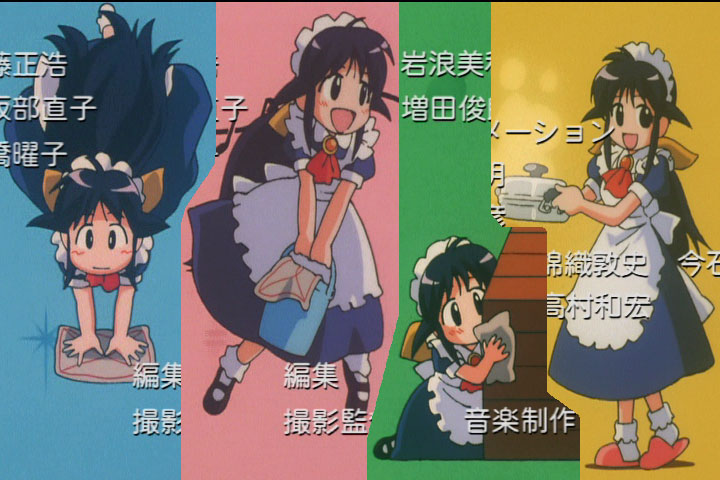Mahoromatic Vol.1 Limited Edition
Created/Updated 2001-12-22
- Catalog Number : PIBA-1296
- Manufacturer : Pioneer
- Series : Mahoromatic
- Printing Date : 2001-12-07
- Region : 2
- Price : Y5,000
- Play Time : 50 minutes
- Number of Discs : 1
- Number of Sides per Disc : 1
- Number of Layers (side1) : 1
- Number of Layers (side2) : N/A
- Audio1 : Japanese Dolby Digital 2ch
- Audio2 : N/A
- Audio3 : N/A
- Audio4 : N/A
- Audio5 : N/A
- Subtitle1 : N/A
- Subtitle2 : N/A
- Subtitle3 : N/A
- Subtitle4 : N/A
- Subtitle5 : N/A
Animephile Rating: C (7.5)
- Video Scan Type : interlaced-TV (-2.5)
- Aspect Handling : anamorphic-ANY (-0.0)
- Compression : -0.0
- Video Separation : -0.0
- Scene Transition : -0.0
- Calibration : -0.0
Comments:
To be honest, I was absolutely not expecting much from this series. I
was going to reconsider purchasing more volumes after I got the first
one. You know? It's actually pretty good. I mean, everyone is enjoying
their part. Heck, I haven't liked any of Takada-san's role since Aeka
until now. All the characters are kind of cookie and fun in a backwards
kind of way. I'll have to see more to be sure, but for now, it sure looks
like a winner.
Image1: These parts of the opening sequence are screaming "These were handled
by Hideaki Anno, the Otaking!"
Image2: Another silk-screening put under the top polymer layer. Sweet!
Image3: The beauty of Japanese animation is in the utilization of the
high performance processing units built into our brains. I've picked
out only the unique foreground images. There aren't that many unique
frames and yet each frame makes great impression on the viewers. In
fact, if there were too many in-between frames, none of the frames
would make an artistic impression on the viewer as they go by. This
is why I believe Japanese animation is far more artistic than American
ones. I dread the bobbing heads of American theatrical animation, by
the way. For the same reason, I don't like Production I.G. stuff
much. They're P.I.G.
For the extra browny point, get me the one missing unique frame. (It
wasn't particularly intentional, but I didn't want to manually do
inverse telecine on another frame.)
Images:





